- Additional fiscal aid news, mixed financial sector results pressure markets
- Consumer stocks likely winners amid expected stimulus
American equites dropped during the final day of trade last week as the S&P 500, Dow Jones, NASDAQ and Russell 2000 each took a hard tumble on Friday, after major Wall Street banks provided mixed Q4 earnings results and retail sales figures for December came in below expectations.
With markets finally receiving confirmation late Thursday from U.S. President-elect Joseph Biden that an additional stimulus package would be forthcoming after his inauguration on Wednesday, Jan. 20, equities are likely to pause during the upcoming week while awaiting the new President's next moves.
Financials, Energy Shares Sold Off
Equity investors took some profit at the close of last week's trade, after soon-to-be President Biden announced his $1.9 trillion COVID relief package, pressuring the SPX lower by 1.5% from the previous Friday's record. However, stocks probably didn’t slip only because investors who'd bought the rumor of additional fiscal aid with Democrats at the helm were now selling the news.
There's a rising sense of geopolitical risk as well, as the pandemic continues to escalate across the US and many parts of the world while vaccine distribution has been disappointingly slow. An additional hazard is the rapidly spreading mutated strain of the coronavirus that's appeared in a variety of locations worldwide.
The S&P 500 slumped for a second straight day on Friday.
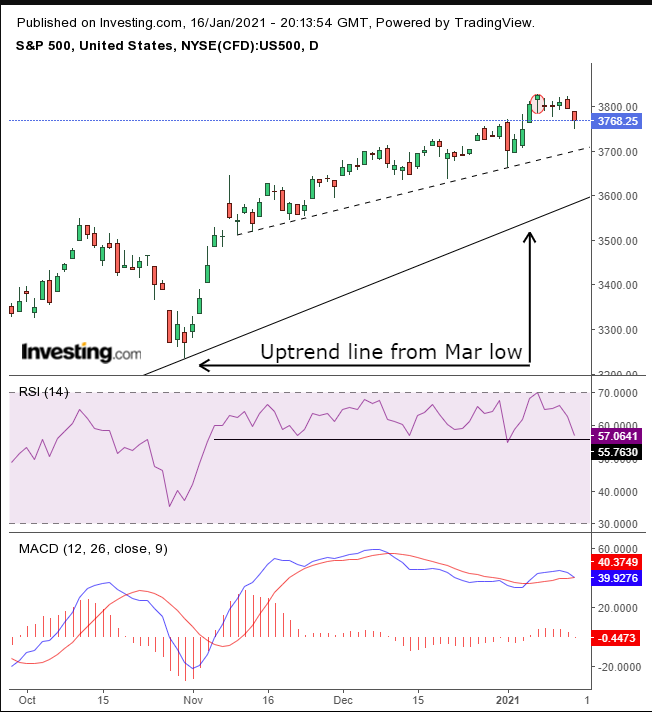
The benchmark index finally broke down after it was unable to shatter the resistance of a confirmed hanging man. The RSI and MACD appeared to be preparing to top out, sending the price to retest the uptrend line from the March low.
The banking sector was sold off on Friday after JPMorgan Chase (NYSE:JPM) and Wells Fargo (NYSE:WFC) reported weaker-than-expected fourth-quarter earnings. WFC plunged, (-7.8%), after missing revenue estimates. CNBC’s Jim Cramer attributes the dramatic selloff to fewer people taking loans during the pandemic and WFC CEO Charles Scharf 's straight talk being received as soft guidance.
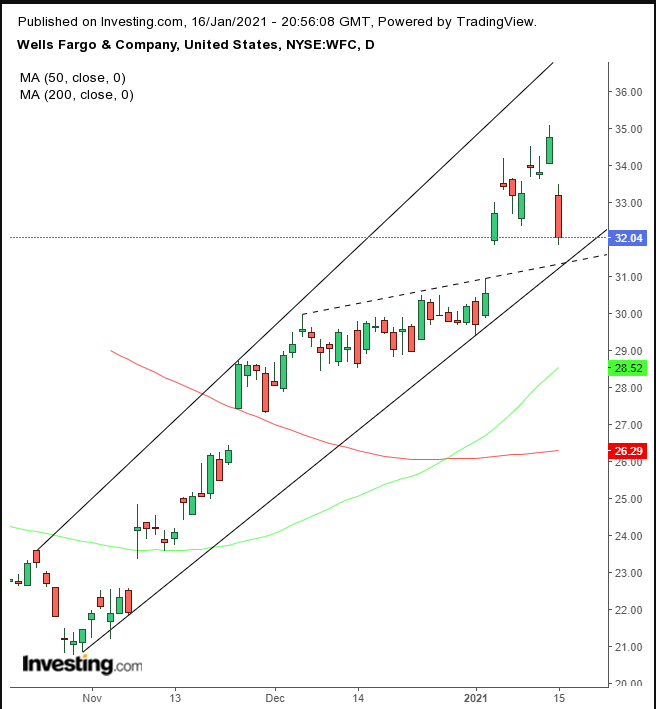
Technically, this could be a buying dip, a correction within a rising channel, after the 50 DMA crossed over the 200 DMA, triggering a golden cross.
The broad benchmark was also dragged down by energy shares, (-3.9%), as Exxon Mobil (NYSE:XOM) dropped 4.8% on news it's being investigated for overvaluing assets.
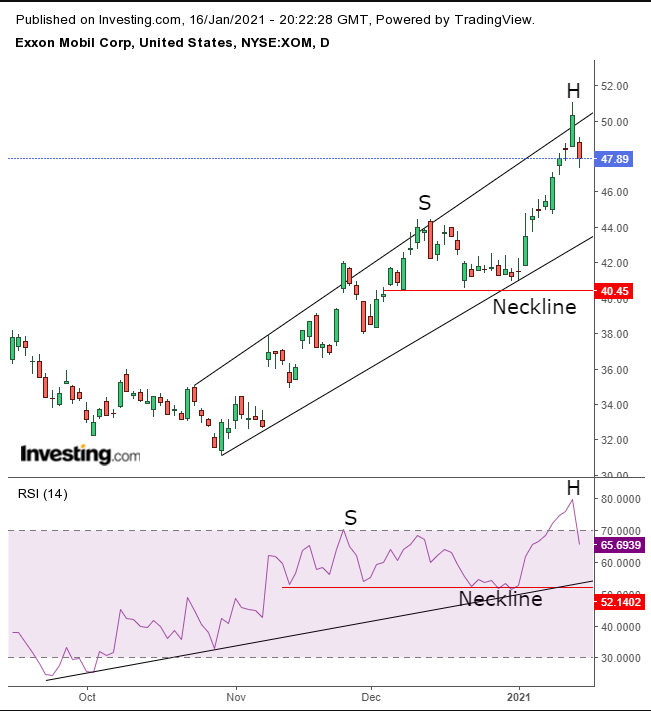
The stock completed an Evening Star at the top of a rising channel. The price should retest the bottom of the channel, but the RSI of 80, indicating shares are extremely oversold, may be signaling the formation of a H&S top.
Real Estate outperformed on Friday, (+1.5%), and climbed 1.9% for the week, after the Fed suggested it will keep interest rates at record lows.
On a weekly basis the S&P 500 slipped, for the first time in three weeks. With a 1.5% loss for the week, it was the index's worst performance in 11 weeks.
Yields, including for the 10-year Treasury note, retreated after surging 20 basis points in the previous week, the most since the near-24 basis points it gained in the first week of June.

Last week’s Treasury selloff pushed yields above the psychological 1% level for the first time since March.
The expectation of additional stimulus, along with rising commodity prices and a lower dollar created the possibility of higher inflation ahead, for the first time in years, prompting demand for bonds with higher yields, as accelerating inflation would erode the purchasing power of Treasuries’ future cash flow.
Last week’s inflation data, however, revealed only a small gain in prices for December. Core CPI (excluding volatile food and energy) expanded 1.6%, well below the 2.2% average of 2019, before the pandemic.
From a technical perspective, yields found resistance at Wednesday’s falling gap, which followed Tuesday’s shooting star when rates failed to break free of a rising channel, in an attempt to ascend at a steeper angle. The 78 RSI was the most overbought since October 2018 when yields peaked at 3.26%.
At this point, rates have a long way to fall before hitting the bottom of the rising channel, while still maintaining their upward trajectory.
The dollar climbed on Friday, sealing a second weekly gain, for the first time since early September.
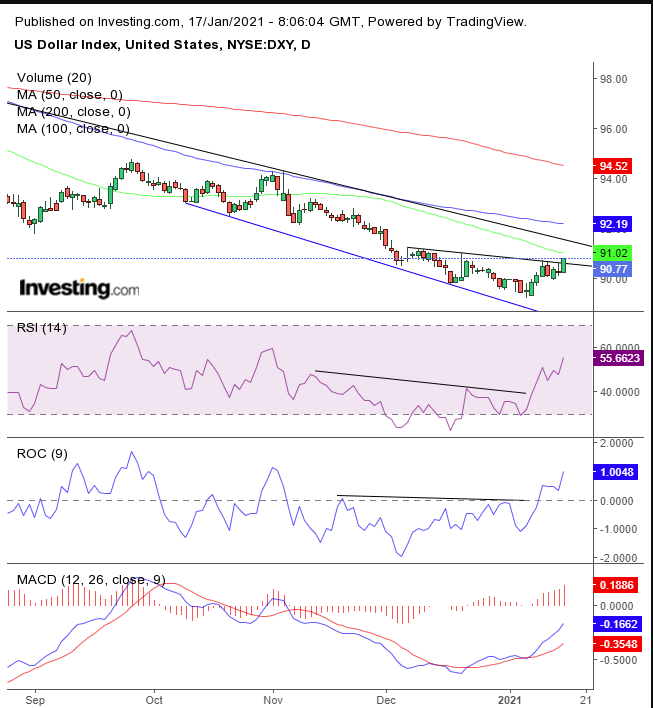
Technically, the USD closed slightly above a trendline in place since Dec. 7, potentially giving the greenback the impetus to take on the downtrend line since the March high. While this view is backed by the RSI, ROC and MACD all bottoming, it could also be rising along the natural downtrending pattern within a falling channel since Oct. 9, while remaining within the larger such channel since the March peak.
After failing to hold a 3% upside breakout, the price of gold retreated below the 200 DMA.

The precious metal is developing a pennant that's bearish after the 7.3% plunge within just four sessions.
Bitcoin is down 6.2% over the weekend, extending its 10.25% plunge from last week. It was the first losing week after four consecutive weekly gains for the cryptocurrency, the longest winning streak since mid-November’s 5 straight weeks of gains.
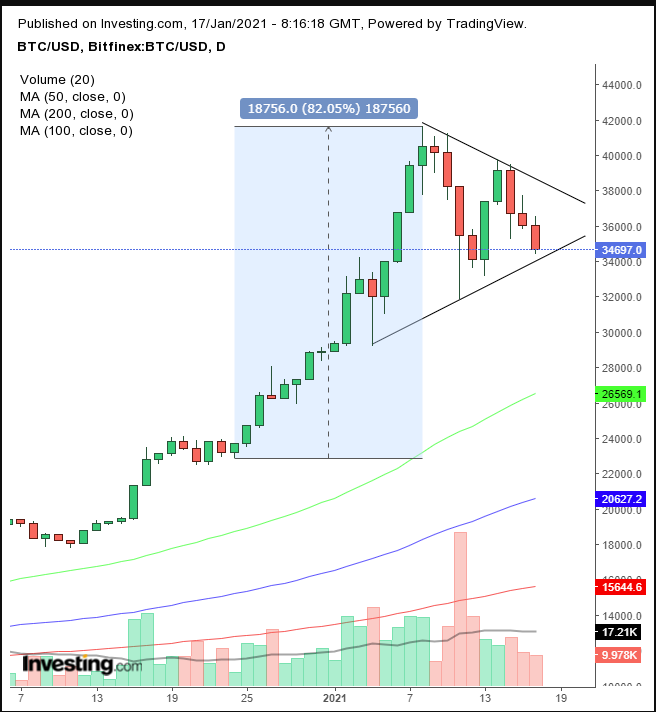
The digital currency has been trading within a pennant since Jan. 4, bullish after its mind-boggling, 82% acceleration in just 16 sessions. An upside breakout would imply a repeat of the near-$19,000 surge preceding the pattern.
Oil receded from a 10-month high amid a strengthening dollar.
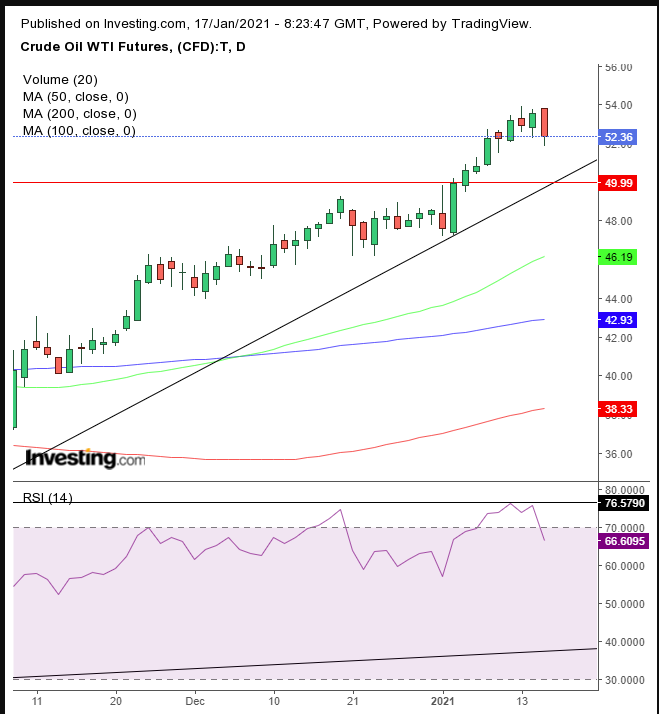
Technically, crude developed a Bearish Engulfing pattern which occurs when a second red candle opens higher but closes lower than a previous green candle. At the same time, the RSI retreated after registering the overbought condition of 76, the highest since January 2018.
The candlestick's two-day bearish pattern, however, may be muted after last week's mostly sideways move, rather than an immediate, steep rise, which would give bears added ammunition. The test will be the uptrend line at the psychological, key $50 level.
The Week Ahead
All times listed are EST
Sunday
21:00: China – GDP: seen to have risen to 6.1% from 4.9% YoY, and 3.2% from 2.7% QoQ.
21:00: China – Industrial Production: expected to dip slightly to 6.9% from 7.0%.
Monday
US Markets Closed for the Martin Luther King Jr. Holiday
8:30 – BoE Gov Baily Speaks
Tuesday
5:00: Germany – ZEW Economic Sentiment: anticipated to rise to 60.0 from 55.0.
20:30: China – PboC Loan Prime Rate: previously set at 3.85%.
Wednesday
2:00: UK – CPI: probably advanced to 0.5% from 0.3% YoY.
5:00: Eurozone – CPI: viewed to have remained flat at -0.3%.
8:30: Canada – Core CPI: anticipated to have dropped to -0.2% MoM from 0.2%.
10:00: Canada – BoC Monetary Policy Report, followed by Interest Rate Decision.
10:30: US – Crude Oil Inventories: seen to have replenished to -2.266M from -3.247M.
Tentative: US President Biden Speaks: after swearing-in, the new US President will address the nation.
19:30: Australia – Employment Change: expected to plummet to 50.0K from 90.0K.
Thurday
7:45: Eurozone – ECB Interest Rate Decision
8:30: US – Building Permits: seen to drop slightly to 1.604M from 1.635M.
8:30: US – Initial Jobless Claims: predicted to shrink to 795K from 965K.
8:30: Eurozone – ECB Press Conference
19:30: Australia – Retail Sales: printed previously at 7.1%.
Friday
2:00: UK – Retail Sales: seen to have surged to 0.9% from -3.8%.
3:30: Germany – Manufacturing PMI: expected to have slipped to 57.5 from 58.3.
4:30: UK – Manufacturing PMI: likely remained steady at 57.3.
4:30: UK – Services PMI: expected to remain flat at 49.9.
8:30: Canada – Core Retail Sales: will probably have slumped to 0.3% from 1.0%.
10:00: US – Existing Home Sales: expected to retreat to 6.54M from 6.69M.
